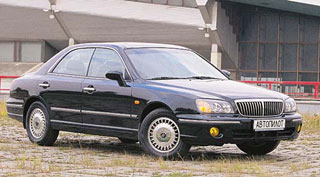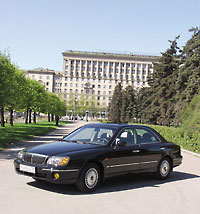Hyundai XG Test drive 1999 - 2003 sedan
Roadside Picnic
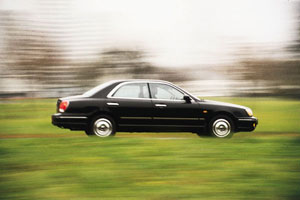 Recently, cars began to come across on Moscow streets, which in appearance are drawn to the representative class, but are difficult to identify. A large solid body - without any characteristic features, a massive chrome radiator grille - without a hint of the emblem ... What is it going? The car sails past, and on the lid of the trunk you see the inscription Hyundai, an oval with a characteristic stroke and a nameplate XG25. What a meeting! Did not recognize. Not surprising...
Recently, cars began to come across on Moscow streets, which in appearance are drawn to the representative class, but are difficult to identify. A large solid body - without any characteristic features, a massive chrome radiator grille - without a hint of the emblem ... What is it going? The car sails past, and on the lid of the trunk you see the inscription Hyundai, an oval with a characteristic stroke and a nameplate XG25. What a meeting! Did not recognize. Not surprising... It is worth a little squint - and it is quite possible to imagine that in front of you is some American, Lincoln there or Cadillac - sizes, impressiveness, abundance of chromium at the front line ... The Japanese trace is also visible - the middle part of the body is as if borrowed from Mitsubishi Diamante. Both that and the other is understandable. Firstly, the Korean company began its activities with the licensed production of Mitsubishi cars, and now technical cooperation is ongoing. Secondly, the machine is almost a representative class, such a bright personality is contraindicated. In addition, the company is actively promoting the Hyundai XG to foreign markets (a car has been sold in Europe for a year, deliveries to the United States are starting from January) and is trying to please everyone at once.
It will turn out or not is a question. Relatively low prices have become the main trump card of Koreans for a long time, but so far it concerned only mass models of low classes. Now, mastering the representative niche, the company enters the territory unfamiliar to it, where the image of the machine sometimes plays a more important role than the price ...
Let's get back to the car. The car looks solid, but at the same time not heavy. It is believed that Hyundai XG is a completely independent development. However, the constructive similarity of many nodes and platforms XG and Diamante is obvious. There is nothing wrong with that, rather the opposite. The front -wheel drive, a transverse engine, the front suspension on the transverse levers, the back is multi -link. Pact stability stabilizers - both in front and behind. However, we have already met with Hyundai XG - in order not to repeat ourselves, we will send those who wish to the previous publication (motor #3, 2000).
Last winter, we rolled the Hyundai XG30 with a five -speed adaptive automatic machine and the HIVEC control system. This time, we had a version with the XG25 nameplate on the trunk lid, i.e. Simple - with the Motor Message (2.5 l 24 -valve V6; 163 hp, 230 nm) and an automatic but four -speed box, which, however, like an older sister, is capable of manually.
The rest is unchanged. Disk brakes on all wheels (frauded in front), ABS, electronic brake force distributor EBD, a traction control system on the drive wheels - the chassis is packed in full accordance with the requirements of the class.
Last time, we decided that Hyundai XG is the main car for the passenger. Now this opinion is only strengthened. In the cabin made in cream colors, light and comfortable. Wide rear doors provide the ease of entry-exit. You can sit in the back relaxing, almost stretching your legs, even if the driver pushes his chair to the stop. Above the head and shoulders there are plenty of place. The seats are moderately tough. Velor upholstery is not as rich as the skin, but at home. The trunk of a very decent volume can be penetrated both in the usual way and from the cabin.
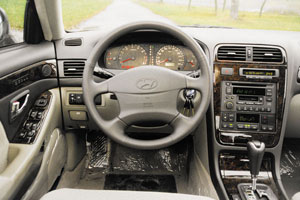 We took care of the driver, his seat is no less convenient - you do not fall, but you do not bounce. Decent lateral support. Electric adjustments, the range of longitudinal movements is huge. The angle of inclination of the steering column can be changed, so it is not difficult to achieve the necessary planting.
We took care of the driver, his seat is no less convenient - you do not fall, but you do not bounce. Decent lateral support. Electric adjustments, the range of longitudinal movements is huge. The angle of inclination of the steering column can be changed, so it is not difficult to achieve the necessary planting. The console is trimmed under a tree, an ashtray and cup holders advanced with a pleasant, well -goned effort. The general quality of execution is noticeably higher than on less cool Korean cars. There is a music center, climate control with automatic inclusion of recirculation mode, an on-board computer, the display of which displays information about fuel consumption, margins and has passed on the way (the font seemed to be some kind of children) ... Much of the other on others Machines are an option, Hyundai XG is included in standard equipment.
The gearbox selector - in the right place, convenient in both automatic and manual mode. The driver will remind the scale of the selected program in the device combination.
The engine is launched and warmed up (it is not heard at all on idle), the selector lever is in position D ... stop, the indicator in the device combination requires the parking brake, but I do not find the lever in the usual place. Ah, that's the matter - Japanese things. Instead of a handbrake - a scabbard, a small pedal on the left (by pressing it, the driver puts the car on the parking lot, and removes the lever on the torpedo to the left of the steering wheel). You can go ...
The gas pedal is quite sensitive and allows you to accurately lead the engine speed. The speed set is not too frisky, it feels that the engine is hard to cope with the weight of the car. I try to drown the pedal on the floor. A little better, but the spirit does not capture. The impression is that 163 horses under the hood are still foals, have not grown.
The transition to the manual mode of control of the box of radical changes did not bring, although the set of speed began to pass intensively. The programs are switched smoothly and almost imperceptibly, without jerking and shabby - which is automatically, in manual (it is a little strange to change the gears without using the clutch). A jumping green light in a combination of devices shows which transmission is turned on.
On the smooth coating, the move is very smooth, the car almost does not notice road roughness. But the suspension is so soft and non -submarine that the irregularities are a little larger to go to the body, and on gentle waves the car sways significantly. (When a lying policeman is moving, we recommend reducing at least twice that, if you don’t want to hook the road with a front, in this regard, in this regard, the Hyundai XG behaves like a real American barge.
But what is interesting. With the design of the suspension, absolutely everything is in order - other rivals will envy. The point is the settings. I heard that the company selects them separately for each market. Perhaps we got a car configured for smooth movement in straight and normal smooth asphalt. In short, for a country with completely different roads ...
The degree character of the Hyundai XG is most clearly manifested in corners. At normal speed, the car passes them with dignity. But if you hurry it, it is quite possible to remove the standard scene of the chase for an American action movie - when the police dreadnoughts like Ford Crown Victoria jump out with a skid out of the corner at smoking rubber (it does not matter that the Hyundai XG is a front -wheel drive, he will roll and smoke no worse) .
The steering wheel ... You can’t call it sharp, with an increase in speed, the reverse effort does not increase very much, but you can steer in the bend confidently - if you take into account the pending features and choose all the gaps in advance. The lamb shows a strong desire to return to zero, especially when accelerated. When leaving the turn under the gas, it must be kept stronger - it can break out of the hands on some bump.
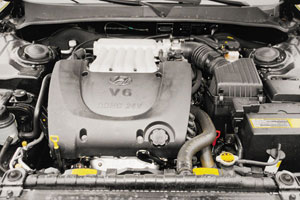 Hyundai XG brakes are good - if you already find a common language with the machine and talk in a calm environment without raising your voice (with standard braking, in a simple way). With emergency - worse, and again the suspension setup is to blame. Even in its direct softness, it leads to such a significant redistribution of the masses between the bridges that the ABS (by the way, the four -channel) is lost, blocking the wheels longer than necessary, and increasing the braking distance. And about what will happen, if suddenly you have to sharply slow down in a bend, into which the foolishness flew with a blurred front wheel, it’s even scary to think ...
Hyundai XG brakes are good - if you already find a common language with the machine and talk in a calm environment without raising your voice (with standard braking, in a simple way). With emergency - worse, and again the suspension setup is to blame. Even in its direct softness, it leads to such a significant redistribution of the masses between the bridges that the ABS (by the way, the four -channel) is lost, blocking the wheels longer than necessary, and increasing the braking distance. And about what will happen, if suddenly you have to sharply slow down in a bend, into which the foolishness flew with a blurred front wheel, it’s even scary to think ... Disappointed? If so, in vain. It has long been said: everyone has their own. No one expects a sports car of a sports car from a commercial van. Why demand this from Hyundai XG, a representative of a representative class? He must move so - smoothly and through smooth asphalt, and not wind from the wall to the wall and from the floor to the ceiling of his main inhabitant - passenger. However, the driver may well be a passenger, because the Hyundai XG (which is 25, 30) is most likely to buy for themselves, and not for the branded fleet.
Yes, it is difficult in Russian conditions to remove cream from the aspirations of foreign car manufacturers directed outside, completely past us. As if you grab and try pieces prepared for a completely different table. Right on the Brothers Strugatsky - a picnic on the sidelines. Unfortunately...
In the American market, the company is counting on an average buyer at the age of 45, mainly male, with an annual income of $ 80,000, which requires a comfortable car for long trips, with a smooth passage, which at the same time can overcome a couple of ascent to get to the house in the house in the house mountains. Hyundai XG30 (XG25 is not supplied to him) will be sold for $ 23,000. - 10-12 thousand cheaper than competitors similar in equipment.
In the UK, which is famous for high prices for cars, sophisticated Hyundai XG30 is offered for 20.999 pounds (for this money you can buy Opel/Vauxhall Omega, but only with 2 liters of a manual box, without music and a hatch in the roof). Similar to equipping the car will cost about 4000 pounds more.
And what do we have? In Moscow, for the Hyundai XG25 they ask for about $ 25,000 (we leave a comparison with competitors' prices). Minus of the car - adjustment of the suspension (fixable case). But this is from the point of view of an active driver who will not think about XG. Everything else is pluses. A solid, comfortable, spacious and well -equipped car for those who appreciate peace and comfort not only at home, but also on the road.
Text: Ivan Sergeev
Source: Motor magazine [No. 12/2000]






